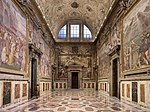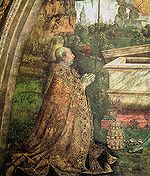The Vision of Constantine (Bernini)
1670s sculpturesCultural depictions of Constantine the GreatEquestrian statuesSculptures by Gian Lorenzo BerniniSculptures in Italy

The Vision of Constantine is an equestrian sculpture by the Italian artist Gian Lorenzo Bernini, located in the Scala Regia by St. Peter's Basilica in Vatican City. Originally commissioned as a free standing work of art within St. Peter's itself, the sculpture was finally unveiled in 1670 as an integral part of the Scala Regia - Bernini's redesigned stairway between St. Peter's Basilica and the Vatican Palace. Unlike other large works by Bernini, art historians have suggested that this work was almost entirely undertaken by him - no other sculptors have been recorded as receiving payment. Bernini's overall fee was 7,000 Roman scudi.
Excerpt from the Wikipedia article The Vision of Constantine (Bernini) (License: CC BY-SA 3.0, Authors, Images).The Vision of Constantine (Bernini)
Viale Oscar Romero,
Geographical coordinates (GPS) Address Nearby Places Show on map
Geographical coordinates (GPS)
| Latitude | Longitude |
|---|---|
| N 41.902777777778 ° | E 12.455 ° |
Address
Palatium Apostolicum
Viale Oscar Romero
00120 , Vatican City
Vatican City
Open on Google Maps











